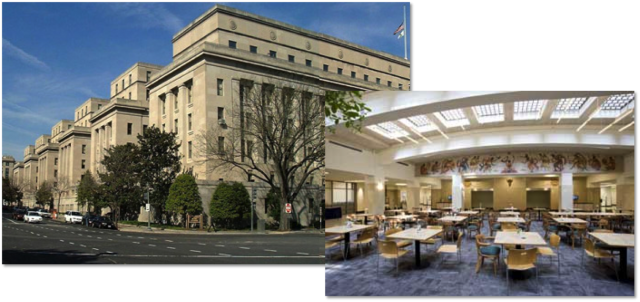
When the new Department of the Interior (DOI) headquarters opened in 1936, employees enjoyed the latest in building amenities and technologies: a gymnasium, movable steel office partitions, a soda fountain, and the first air conditioning system in a large federal building. Construction of the 1,300,000 SF structure in D.C.’s Foggy Bottom neighborhood took only 18 months, but renovating the interior to 21st Century requirements presented a more complex task. DOI, a tenant of the General Services Administration (GSA), chose to pursue sustainability standards set by LEED (Leadership in Energy and Environmental Design) for Commercial Interiors (LEED-CI), a rating system developed by the U.S. Green Building Council (USGBC) for high performance tenant spaces. The six-phase project respected the historic site’s exterior while constructing a new chilled water plant, incorporating dedicated outdoor air systems, installing dimmable and sub-metered lighting and adding low-flow faucets and other water-saving upgrades. In December of 2012, the renamed Stewart Lee Udall Department of Interior Building was recognized as LEED-CI Certified. Two spaces within the headquarters, the DOI childcare center and the cafeteria, reached even higher sustainability standards and were awarded LEED-CI Platinum.
When LEED launched in 2000, it began as a single rating system aimed at improved energy efficiency and other sustainable advancements in the construction of new buildings. Calls for other rating systems soon followed, with architects, interior designers and others requesting a rating system that would promote environmentally responsible decision-making for interiors-only projects. The GSA, recognizing the importance of enabling tenant sustainability improvements, provided grant money to support a LEED-CI pilot program, which launched in summer, 2002. Projects selected for the pilot were located around the country and varied in scope, purpose and budget. Feedback resulted in a system applicable to tenant spaces in commercial buildings, including offices, healthcare facilities, hotels and educational buildings. The format and structure followed LEED version 2.0, with the same intention behind credits but variations in requirements when necessary. Also, more emphasis was often accorded to materials and resources and indoor environmental quality impacts of furniture and furnishings in interiors fit-outs.
To date, 85 federal projects have been awarded LEED-CI at some level (Certified, Silver, Gold or Platinum). Besides the Interior headquarters, examples include an Arlington, VA, office suite, a neurotoxicology laboratory in Reno, NV, and the Warren E. Burger Federal Building and U.S. Courthouse in St. Paul, MN. Tenants aspiring to LEED-CI must first register their space with the Green Building Certification Institute (GBCI), an organization established by the USGBC to administer the LEED program. Through GBCI’s LEED Online, interiors project teams can:
- Work together to manage project details;
- Complete documentation requirements for LEED prerequisites and credits;
- Upload supporting files and submit applications for review; and
- Receive reviewer feedback.
To achieve certification in LEED-CI—generally required for GSA leases larger than 10,000 SF—each project must earn points in 7 categories: sustainable sites, water efficiency, energy and atmosphere, materials and resources, indoor environmental quality, and regional priority. A minimum of 40 points is required to qualify as Certified, while projects seeking Platinum need at least 80 points out of a possible 110.
Specifics for earning points depend somewhat on which LEED version is used, which in turn depends on the date of project registration. But experienced LEED-CI users recognize some ways that tenants can earn some relatively easy points. These include leasing space in a LEED certified building near public transportation, installing occupancy and daylight sensors and EnergyStar equipment, buying used furniture and local materials and using FSC-certified wood. Notably, committing to stay in the location for 10 years can earn one point because simply moving a business consumes natural resources.
Of course, challenges remain for tenant spaces seeking LEED-CI certification. Even before registering a project, tenants and building owners or managers should work together, determining if the project can meet minimum requirements (e.g., 250 SF floor area and 1 or more full time equivalent occupants) and can comply with local and state codes and laws. Tenant/landlord cooperation can also smooth the way toward credits such as alternative transportation (e.g., bike storage), recyclables collection and tobacco smoke control. And cooperation in the lease agreement may be advisable to earn points for measurement and verification; negotiation to have energy and water sub-meters installed and energy and water use costs separated from base rent may be advisable. Ideally, tenants seeking LEED-CI can work with landlords pursuing certification through LEED for Core & Shell, a rating system established for developers preparing base buildings for environmentally conscious tenants.
LEED v4 launched in November at the USGBC’s annual Greenbuild Conference. Credits have been revised, shifted and removed, with new and more stringent standards for materials and products that recognize environmental impacts throughout their lifecycles. Clear comparisons of LEED 2009 and v4 can be found in the v4 User Guide. Options for interiors projects also expanded recently, when the GSA endorsed two third-party green building certification systems: LEED 2009 and Green Globes 2010. The latter system offers the Fit Up program to guide energy and environmental design of new or remodeling of existing interior commercial spaces. Both systems recognize that environmentally sustainable interior spaces can save energy and money while improving worker productivity and increasing building value for the long term.
